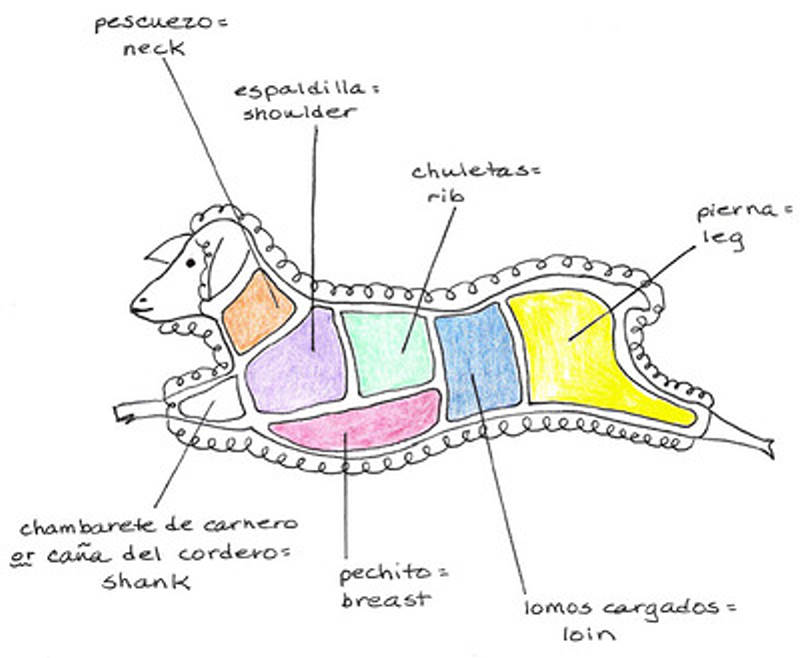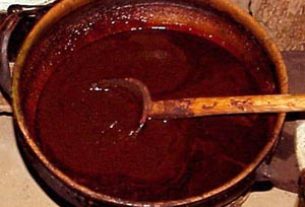Mexican Kitchen by Karen Hursh Graber
Continuing a look at meat cuts and how they are named and used in Mexico, we will first consider pork. The old saying that you can eat every part of the pig but the squeal is especially true in Mexican cuisine. In addition to the more familiar cuts of loin, chops, etc., there is extensive use of tripe, head and trotters. The array of chorizo and longaniza draped overhead inside the butcher shop, and the huge pot of pork rinds bubbling away in lard outside, are evidence of a deep fondness for the meat of this animal.
However, the taste for porky products was an acquired one. The indigenous people of pre-Hispanic Mexico did not have domesticated pigs, and had an aversion to animal fat. Although the javelina, or collared peccary, found in the wild in parts of the country, is a distant relative of the pig, it is so distant that students of animal classification do not even put them in the same family. The javelina does not produce fat, and this may be why it was hunted and eaten in the Yucatan and other regions.
But with the Spaniards came their pigs, a mainstay of Spanish cuisine. The pig was the first animal for food consumption the Europeans brought to Mexico, and herds of porkers accompanied Cortes on his trek across the base of the Yucatan peninsula. He kept the pigs four days behind his soldiers as a way of conserving his stock. Later, pork was the first European meat to have a price set for it in Mexico City, although for the first years of the Colonial period, meat was not sold to non-Europeans.
The Spanish stock proliferated in Mexico, and created problems for native farmers who were not accustomed to protecting their crops from the destructive pigs. It was not until indigenous intermarriage with Spaniards became more common that the dietary habits of the two cultures merged, and pork took on an important role in the national culinary repertoire. Fairly easy to raise and feed, and with nearly nothing going to waste, pigs were kept by families in both the countryside and small towns. Even today, in our town of Cholula, piggies can be heard squealing behind gates not too many blocks from the town square.
Shopping for pork is not quite as challenging to newcomers to Mexico as figuring out the cuts of beef, but here, too, nomenclature is important. Pork chops are chuletas de puerco and ground pork is puerco molido. Flat pieces for breading and frying are milanesas. Most Mexican pork is quite lean, but to be sure all fat is removed, ask for the meat sin grasa, without fat, and every last ounce will be removed. Mexican butchers are meticulous about trimming fat, which will be melted to fry pork rinds and carnitas. The pork rinds are called chicharrones, and the lard itself is manteca. Carnitas are pieces of fried pork meat, often cooked with orange rind for a distinctive flavor.
The animal’s intestines are called tripas, and are used to make the famous hangover remedy soup, menudo. The head (cabeza) is much appreciated in the hominy stew pozole. Some parts of the head, such as the oreja (ear), trompa (snout), and buche (cheek) are favored for tacos de carnitas, as are the skin and organ meat. Pickled pig skin is called cueritos.
Other names for pig are cerdo, cochino and marrano, and a suckling pig is called a lechón. The following are the major cuts of pork and how they are used. (See diagram.)
CORTES DE PUERCO: CUTS OF PORK

Espaldilla: Shoulder Or “Boston Butt” (Roast, stew, panfry)
From this cut come blade roasts and pork steaks, not commonly cut as such in Mexico, as well as milanesas de puerco, the flat, panfried pork cutlets. Carne de puerco para guisar, or pork stew meat, is frequently cut from this section, as is meat for making the spicy sausages called chorizos.
Pecho: Fore Shoulder or Picnic Shoulder (roast, grill, panfry)
This cut is sometimes called the paletilla, and is used for stew meat in Mexico, and for smoked and fresh picnic ham north of the border. It can also be used in making chorizo sausages.
Loin
The cut labeled loin north of the border is generally known by two different names in Mexico, differentiating between the rib loin and the mid loin or tenderloin.
Espinazo: Rib loin (Roast, stew, panfry)
From this cut come back ribs (costillas) and chops (chuletas) as well as rib roast (chuleta en trozo.) Espinazo con verdolagas, pork with purslane, is a popular dish in central Mexico, a distant relative of the pork with greens served in the southern United States, but with the characteristic flavor of chiles. Pork chops are frequently smoked in Mexico, and easier to find than regular pork chops.
Lomo: Mid Loin (Roast, grill, panfry)
This yields the boneless pork tenderloin, simply called lomo, cooked whole as a roast or cut into filets called medallones (medallions).
Costillita: Spare Ribs (Roast, grill, stew)
These can be marinated and roasted or grilled, but in Mexico they are most frequently stewed. If a rack of ribs for grilling is what you want, make sure to ask the butcher not to cut them apart. Mexican butchers, unless asked otherwise, will whack a rack of ribs horizontally and then cut it into small pieces.
Falda: Side Pork (Stew, panfry)
This is located alongside the stomach and is most frequently used to make bacon (tocino). It can also be boiled and shredded for filling tamales and other cornmeal-based snacks.
Pierna: Leg (Roast, braise)
This can be cut up for stew or roasted in a large piece. It is more marbled than the loin and is a good choice for longer-cooking dishes such as cochinita pibil, a specialty of the Yucatan, and asado veracruzana, a chile-rubbed pork roast. This cut is also smoked to make ham. The boneless upper part of the pierna is commonly called pulpa.
Codillo: Hock (Braise, stew)
In some places, the upper, meatier part of the hock is called the chamorro. It is usually stewed or braised, and frequently served in a tomatillo-based green sauce.
Pata, Mano: Trotters
The trotters are much beloved in Mexico for pickling and serving on tostadas. The terms pata and mano distinguish the rear from the fore trotters. The entire hock and trotter portion is sometimes (confusingly) called pata or mano, but placing an order of tostadas de pata will definitely result in getting a topping of pickled pigs’ feet. Many foreigners shy away from these, but the gelatinous consistency of the trotters is a good contrast with the crispness of the tostada.
LAMB
Here in Puebla, there is a saying that refers to the best meat and the best fish: del mar, el mero, y de la tierra, el carnero, which basically means that the best food from the ocean is the grouper and the best from the land is lamb. While not everyone would agree with this, it seems to hold true in the central Mexican states of Puebla, Tlaxcala, Hidalgo and Estado de Mexico, where lamb is highly prized.
It is considered the best meat for barbacoa, the deep-pit technique favored for cooking whole animals. After being wrapped in leaves, usually maguey, the meat is placed in a hot pit dug in the ground, with a large pot placed underneath to catch the drippings. These make a tasty broth, which is served as a first course before the lamb itself, both at family events and in the restaurants that line the highways and open on weekends just to serve barbacoa. Another specialty in the region is mixiotes de carnero, steamed, leaf-wrapped bundles of marinated lamb. And in Western Mexico, the spicy stew called birria can be made with lamb, although goat is used more often.
While the lamb meat itself is called carnero, the young animal is cordero and the older sheep Borrego or oveja. A lamb chop is chuleta de carnero or chuleta de cordero. Ground lamb is carnero molido, and is a common ingredient in the cooking of the Lebanese immigrants to Mexico and their descendents.
In fact, Western Asia is where lamb had its origins as the oldest domesticated animal 9,000-10,000 years ago. Descended from a wild sheep called the mouflon, it quickly spread westward to Cyprus, Rhodes and Western Europe. In Spain, where open range flock management was practiced, enormous flocks ranged over the entire nation.
The first sheep came to the Americas on Columbus’ second voyage in 1493, followed by others that came to Mexico with Cortes in 1519. Sheep ranching became a successful enterprise in Mexico, focusing on meat production rather than wool production. The most recent World Sheep Congress was held in Queretaro, Mexico, in 2007 and gave Mexican ranchers a chance to demonstrate their best breeds. However, several years of draught in Mexico have made it necessary to import meat, and New Zealand lamb is becoming a fixture in most major Mexican supermarkets.
The following are the major cuts of lamb and how they are used. (See diagram.)
CORTES DE CARNERO: CUTS OF LAMB

Pescuezo: Neck or Scrag (Braise, stew)
The neck of the lamb is most often sold cut in slices (rebanadas de pescuezo) and used to flavor soups and stews.
Espaldilla: Shoulder (Roast, stew)
Lamb shoulder roast is a popular cut in Mexico. This part of the lamb is also cut into cubes for kebabs (brochetas) and stews (guisados.) Blade chops (chuletas de espaldilla) may also be cut from the shoulder, though they are not as lean as the rib chops or loin chops and are best prepared braised.
Chuletas: Rib (Roast, braise, grill, panfry)
This cut yields rib chops (chuletas), crown roast and rib roast. The later two are not prepared much in Mexico, but if you want a whole roast from this cut, ask for chuleta en trozo.
Lomos Cargados: Loin (Roast, grill)
From this come loin chops (chuletas de lomos cargados) and loin roast (lomos cargados en trozo.)
Pierna: Leg (Roast, grill)
Leg of lamb can be roasted or butterflied and grilled. In Chihuahua, pierna de cordero a la parilla is rubbed with a garlic, herb and chile paste before grilling.
Pechito: Breast (Roast, stew)
The breast contains riblets called costillitas, the same as the word for pork spare ribs. The whole breast can be roasted or braised.
Chamberete de Carnero or Caña del Cordero: Shank (Braise or stew)
These can be braised or stewed. They make an excellent soup with the addition of lentils (lentejas) or split peas (chícharro seco).
- Pork Loin Cooked in Orange Juice:Lomo en Jugo de Naranja
- Pork with Apricot-Chile Sauce:Puerco con Salsa de Chabacanos y Chile
- Grilled Chihuahua Style Leg of Lamb:Pierna de Cordero a la Parilla
- Mixiotes de Carnero: Spiced Lamb Steamed in Maguey Leaves
Published or Updated on February 1, 2008by Karen Hursh Graber



